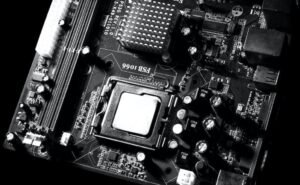Neural Networks Nodes
Neural networks are a type of artificial intelligence that are widely used today in various industries and applications. These networks mimic the functionality of the human brain, enabling computers to learn and make decisions. A key component of neural networks are nodes, which play a vital role in the processing and analysis of data. In this article, we will explore the importance of neural network nodes and their impact on machine learning algorithms.
Key Takeaways
- Neural network nodes are essential building blocks of artificial intelligence systems.
- Nodes perform computations and transfer information between layers in a neural network.
- Activation functions in nodes determine the output based on the input.
Neural network nodes, also known as artificial neurons, are responsible for processing and transferring information within a neural network. These nodes are organized in layers, with each node in a given layer connected to multiple nodes in the subsequent layer. This interconnected structure allows for the flow of data through the network, leading to the extraction of meaningful patterns and insights.
Each node in a neural network performs a computation on the input it receives. This computation involves multiplying the input values by corresponding weights and then applying an activation function to determine the final output of the node. The activation function introduces non-linearity to the network, enabling it to model complex relationships present in the data.
*Fun Fact: The activation function in a node is analogous to the firing of neurons in the human brain, where electrical signals are generated based on the stimulation received.*
Types of Nodes
Neural network nodes can be classified into different types based on their functionality within the network. Some common types of nodes include:
- Input nodes: These nodes receive input data and pass it on to the hidden nodes for processing.
- Hidden nodes: These nodes perform computations on the received data and transfer it to the subsequent layer.
- Output nodes: These nodes provide the final output of the neural network after the data has been processed.
*Interesting fact: Hidden nodes play a crucial role in deep learning models, where they contribute to the extraction of high-level features and abstraction of data.*
Tables
| Node Type | Functionality |
|---|---|
| Input | Receive and pass on input data |
| Hidden | Perform computations and transfer data |
| Output | Provide final output of the network |
| Node Type | Activation Function |
|---|---|
| Input | *None (pass-through function)* |
| Hidden | *ReLU (Rectified Linear Unit)* |
| Output | *Sigmoid or Softmax* |
| Node Type | Example Applications |
|---|---|
| Input | Data pre-processing, feature extraction |
| Hidden | Image recognition, natural language processing |
| Output | Classification, prediction |
Neural network nodes are essential for the successful operation of machine learning algorithms. They enable the network to learn from data and make informed decisions based on the patterns and relationships discovered. Understanding the role and functionality of nodes in neural networks is crucial for developing effective AI models and systems.
With the advancements in artificial intelligence and the increasing complexity of data analysis tasks, neural network nodes continue to play a vital role in pushing the boundaries of what machines can achieve. As research in this field progresses, we can expect further improvements in the performance and capabilities of neural networks, ultimately leading to more powerful and intelligent AI applications.

Common Misconceptions
Neural Networks Nodes
There are several common misconceptions people have about neural network nodes. A neural network is a system of interconnected nodes, or artificial neurons, that work together to process and analyze information. Here are three common misconceptions about neural network nodes:
- Misconception 1: Each node in a neural network performs a specific task independently.
- Misconception 2: The number of nodes directly correlates with the accuracy of the neural network.
- Misconception 3: Removing nodes from a neural network always improves its performance.
Common Misconceptions
Neural networks are often misunderstood, and there are several misconceptions surrounding them. Here are three more common misconceptions about neural network nodes:
- Misconception 1: Neural network nodes are similar to biological neurons in our brains.
- Misconception 2: Increasing the number of nodes always leads to better results.
- Misconception 3: The connections between nodes in a neural network are static and unchangeable.
Misconceptions about Neural Network Nodes
Despite their increasing popularity, neural networks still have misconceptions associated with their nodes. Here are three additional misconceptions:
- Misconception 1: Neural network nodes have self-awareness or consciousness.
- Misconception 2: Nodes in a neural network always have equal importance or influence.
- Misconception 3: The more layers in a neural network, the better its performance.
Debunking Misconceptions about Neural Network Nodes
Let’s debunk some of the common misconceptions about neural network nodes:
- Misconception 1: Nodes in a neural network work together, relying on the input from other nodes.
- Misconception 2: Increasing the number of nodes may lead to overfitting and unnecessary complexity.
- Misconception 3: The weights and connections between nodes can be adjusted through a learning process.
Further Clarification on Neural Network Nodes
To gain a better understanding of neural network nodes, it’s essential to clarify these misconceptions:
- Misconception 1: Neural network nodes are mathematical functions, not biological neurons.
- Misconception 2: The optimal number of nodes depends on the specific problem and dataset.
- Misconception 3: The connections between nodes have varying strengths determined by their weights.

Introduction
Neural networks are powerful computational models inspired by the human brain. They consist of interconnected nodes, or artificial neurons, that process and transmit information. These networks have revolutionized many fields, including image and speech recognition, natural language processing, and even the development of self-driving cars. In this article, we will explore various aspects of neural networks and illustrate key points through a series of tables.
Table 1: Activation Functions
An activation function determines the output of a neural network’s node based on the weighted sum of its inputs. Different activation functions are suitable for different tasks, and they can greatly impact the performance of a neural network.
Table 2: Common Activation Functions
This table provides a comparison of various popular activation functions, including their formulas, typical ranges, and key properties. Each function introduces a different level of non-linearity and offers unique advantages for specific applications.
Table 3: Types of Neural Networks
Neural networks come in various architectures, each tailored to solve specific problems. In this table, we present different types of neural networks, such as feedforward, recurrent, and convolutional networks, along with their characteristics and typical applications.
Table 4: Feedforward Neural Network Layers
A feedforward neural network comprises an input layer, one or more hidden layers, and an output layer. In this table, we delve into the role of each layer and explain their functions within the network.
Table 5: Recurrent Neural Networks vs. Feedforward Neural Networks
Recurrent neural networks (RNNs) differ from feedforward networks due to their ability to retain memory, allowing them to process sequential data. This table provides a comparison between RNNs and feedforward networks in terms of architecture, data processing, and applications.
Table 6: Training Algorithms
To optimize neural networks and improve their accuracy, training algorithms are employed. This table highlights popular algorithms like backpropagation, stochastic gradient descent, and adaptive moment estimation (Adam), along with their characteristics and training advantages.
Table 7: Learning Rates
The learning rate plays a crucial role in determining how much a neural network adjusts its weights and biases during training. This table demonstrates the effect of different learning rates on the convergence and accuracy of the network.
Table 8: Performance Metrics
Measuring the performance of a neural network is crucial in assessing its effectiveness. This table showcases key performance metrics, including accuracy, precision, recall, and F1 score, and explains their interpretation.
Table 9: Neural Network Applications
Neural networks have found applications in a myriad of domains. This table highlights some notable applications, ranging from medical diagnosis and finance to natural language processing and computer vision, with real-world examples.
Table 10: Neural Networks in Pop Culture
The influence of neural networks extends beyond technical applications. This final table explores popular culture references to neural networks, from movies like “The Matrix” to the portrayal of AI in science fiction literature.
Conclusion
Neural networks have become a cornerstone of modern-day technology, empowering breakthroughs in diverse fields. Through the tables presented, we have gained insights into activation functions, network types, training algorithms, performance evaluation, applications, and even cultural references. These tables provide a cohesive overview of neural networks while showcasing the breadth of their impact and potential. With continued advancements, neural networks will undoubtedly shape the future of artificial intelligence and drive further innovation in our ever-connected world.
Frequently Asked Questions
FAQ
What are neural network nodes?
A neural network node, also known as a neuron or a perceptron, is a fundamental unit in a neural network. It receives input signals, performs computations, and produces an output signal. Nodes are interconnected to form layers, and the information flow between nodes enables the neural network to make predictions or solve complex problems.
How do neural network nodes work?
Neural network nodes apply a mathematical transformation, generally a weighted sum of the input signals, followed by the application of an activation function. The weights and biases associated with the nodes are learned during the training process. The activation function introduces non-linearity, allowing neural networks to learn complex patterns and mappings.
What is the structure of a neural network containing nodes?
A neural network consists of an input layer, one or more hidden layers, and an output layer. Nodes are organized in layers, where each node in a given layer is connected to all nodes in the adjacent layers. This layered structure facilitates the flow of information through the network and enables effective training and prediction.
What types of activation functions are commonly used in neural network nodes?
There are several activation functions used in neural networks, such as sigmoid, tanh, ReLU (Rectified Linear Unit), and softmax. These functions introduce non-linearity into the node computations, allowing for more complex representations of the input data. Choosing the appropriate activation function depends on the specific task and the desired properties of the network.
How are the weights and biases of neural network nodes determined?
During the training process, the weights and biases associated with the nodes are learned through an optimization algorithm, such as gradient descent. The network is trained on a labeled dataset, where the weights and biases are adjusted iteratively to minimize the difference between predicted outputs and true outputs. This process is known as backpropagation.
What is the purpose of bias in neural network nodes?
Bias is an additional parameter associated with each node in a neural network. It allows the network to adjust the output even when all the input values are zero. Bias helps the network to learn and represent complex relationships between input and output, increasing the flexibility and range of functions the network can approximate.
Can node connectivity vary within a neural network?
Yes, the connectivity between nodes can vary within a neural network architecture. In some networks, such as feedforward neural networks, each node in a given layer is connected to all nodes in the adjacent layers. In other networks, like convolutional neural networks, the connectivity pattern is spatially constrained and inspired by the visual cortex’s organization.
What happens if a neural network node receives no input?
If a neural network node receives no input, its output would typically be undefined or zero. However, this can depend on the specific architecture and design choices of the network. In some cases, nodes might have a default output value or an assigned constant value when no input is received, ensuring a more stable behavior during computation.
Can neural network nodes work with non-numeric inputs?
By default, neural network nodes work with numeric inputs. However, techniques such as one-hot encoding can be used to represent categorical variables as numeric inputs. Additionally, specialized network architectures, like recurrent neural networks, can handle sequential or textual data by incorporating memory units and specialized node types.
What are the applications of neural network nodes?
Neural network nodes have a broad range of applications, including image and speech recognition, natural language processing, sentiment analysis, recommendation systems, and even autonomous vehicle control. Their ability to learn and recognize complex patterns makes them valuable tools in tasks that involve extracting meaningful information from large datasets.




